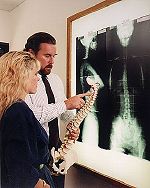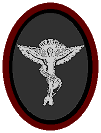| |
|
A. The
disc is a part of the spine that has received a lot of attention lately.
The terms "slipped disc," "ruptured disc," "prolapsed
disc," or "herniated disc" are terms that most people
have heard. However, most people could use a better understanding of
these terms.
The
term "slipped disc" is a layman’s term. The disc cannot
slip - it is knitted into the vertebrae from both above and below. The
vertebrae may
slip or move and put pressure on the disc, resulting in symptoms. The
term "herniated disc" is when the disc bulges to one side.
The bulge may be mild to severe. Remember, the disc is made up of two
parts: a tough, fibrous outer ring (called the annular fibrosis) and
the gel-like center (the nucleus purposes). Over the years, the disc
loses a little fluid and
small cracks (lesions) begin to form in the outer walls. The nucleus
begins to bulge and push the annular fibrosis out of shape. This is
called "protrusion" or "herniated disc." If the
nucleus bulges too much, it may actually separate from the rest of the
disc. This is called a "prolapsed disc." The prolapsed disc
is the most severe of all these and usually
results in severe pain. This disc may also degenerate along with the
vertebrae themselves.
Most
people lose 1/2"-2" in height when they get into their 60s
and 70s. The majority of this height loss is due to the compression
or shrinkage of
the disc. As for treatment, the medical approach to disc problems is
often a combination of painkillers, muscle relaxers, anti-inflammatories,
and physical therapy. If these fail to bring results, surgery may be
suggested. The success of back surgery varies. Symptomatic improvements
such as lessening of the pain is often short-lived. Within one year,
post-surgery, a large number of patients are no better than
before and most symptoms return. In a study of 7,391 operations performed
by 71 different surgeons, 48% had the same symptoms within one year
after surgery as before. Currently, there are approximately 600,000
back surgeries performed per year with about a 50% failure rate!
Chiropractic care has an excellent record with disc sufferers. According
to one study of 1,536 lumbar-spinal-problem patients who were under
chiropractic care, 96.4% had satisfactory results! Surgery was resorted
to in only 3.4% of the patients. This study showed two things: one,
that
chiropractic care is extremely effective with spinal disc problems and
two, that of those who had surgery, the delay in time while they explored
chiropractic care did not cause them any harm.
In
conclusion, the research shows that chiropractic care is very successful
in treating disc problems. I believe that anyone considering back surgery
should first consult a chiropractor for a second opinion in regards
to other options. If I may answer any further questions, please contact
me at my clinic.
  
  

|


